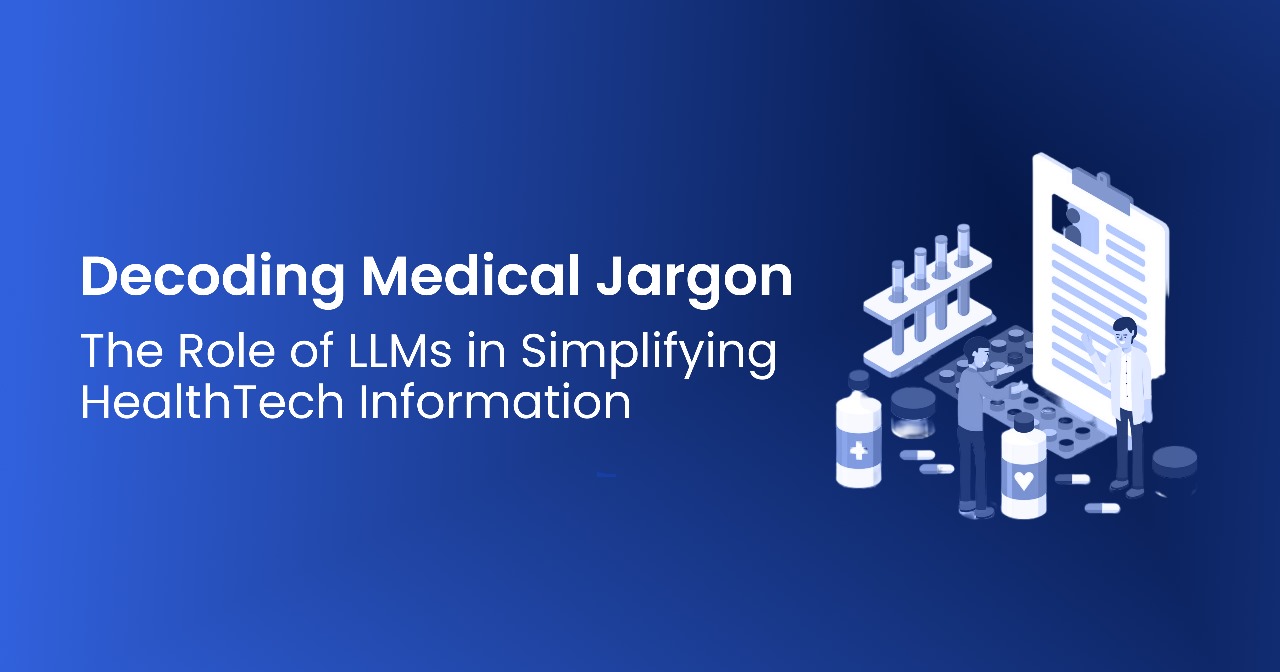Introduction
Medical jargon can often feel like a foreign language to many patients, creating barriers to understanding crucial health information. Terms like “myocardial infarction” instead of “heart attack” or “edema” instead of “swelling” can leave patients feeling confused and anxious. This complexity isn’t just a minor inconvenience; it can significantly impact a patient’s ability to make informed decisions about their health.
In recent years, technology has stepped in to bridge this communication gap, with Large Language Models (LLMs) playing a particularly vital role. LLMs, powered by advanced AI and natural language processing, have the ability to translate complex medical terminology into everyday language, making health information more accessible to everyone.
Simplifying medical language is more than just a convenience—it’s a necessity for improving patient outcomes. When patients clearly understand their diagnoses, treatments, and health recommendations, they are more likely to follow through with their care plans, ultimately leading to better health results. As LLMs continue to evolve, their role in healthcare communication will become increasingly essential, helping to ensure that no one is left in the dark when it comes to their health.
Brief History Of LLMs In The Healthtech Space.
Large Language Models (LLMs), originally developed to improve natural language processing (NLP) tasks like translation and text prediction, have quickly evolved and are now playing a significant role in HealthTech. These models are trained on vast amounts of data, enabling them to comprehend complex language structures and produce coherent, contextually accurate responses.
How LLMs Work In HealthTech
In the HealthTech space, LLMs are particularly valuable for their ability to break down complex medical language. By leveraging NLP, LLMs can analyze and simplify medical texts, making them more understandable for the average person. This is especially important in healthcare settings, where clear communication can directly impact patient outcomes.
How LLMs Simplify Medical Jargon
Large Language Models (LLMs) excel at translating complex medical jargon into language that anyone can understand. They do this by leveraging natural language processing (NLP) to break down intricate medical terms and rephrase them in simpler, more accessible language. For instance, instead of presenting a patient with the term “cerebrovascular accident,” an LLM might translate this as “stroke,” which is far more understandable to the average person.
The integration of LLMs in HealthTech applications has proven to be a game-changer for patient comprehension. These AI-driven tools are embedded in various healthcare platforms to ensure that patients can easily understand the information they receive, whether it’s a diagnosis, treatment plan, or medication instructions. By simplifying medical language, LLMs help bridge the communication gap between healthcare providers and patients, leading to better-informed patients who are more engaged in their care.
Benefits of Using LLMs in Healthcare Communication
-
Improved patient outcomes through better understanding of medical information:
When patients clearly understand the medical information provided to them, they are more likely to follow through with treatment plans and make informed health decisions. LLMs play a crucial role in simplifying complex medical jargon, enabling patients to grasp essential details about their conditions and care, ultimately leading to improved health outcomes.
-
Reduction in the cognitive load on patients, making healthcare more accessible:
The complexity of medical language can be overwhelming, adding unnecessary stress to patients already dealing with health issues. LLMs reduce this cognitive load by translating medical terms into straightforward language, making it easier for patients to comprehend their health information and engage with their care without feeling overwhelmed.
Telemedicine platforms have increasingly adopted LLMs to enhance patient communication. For instance, when a doctor provides a diagnosis via a telemedicine app, the LLM processes the information, rephrasing it into simpler terms so the patient can fully understand their condition and the recommended treatment. This use of LLMs ensures that remote consultations are as effective and informative as in-person visits, fostering better patient outcomes.
Challenges and Considerations
Potential Limitations of LLMs, Such as Accuracy in Medical Contexts:
- Accuracy of Information: LLMs might sometimes generate incorrect or imprecise medical information due to limitations in their training data or inherent model biases.
- Contextual Misunderstandings: LLMs may struggle to interpret the context of complex medical scenarios accurately, leading to potential miscommunication or misinterpretation of symptoms.
- Dependency on Data Quality: The effectiveness of LLMs is heavily dependent on the quality and breadth of the data they were trained on, which can vary and affect their reliability in specific medical contexts.
- Lack of Real-Time Updates: LLMs may not always reflect the latest medical research or clinical guidelines if they are not regularly updated, potentially leading to outdated advice.
Ethical Considerations: Ensuring the AI Remains a Tool for Clarity, Not Confusion:
- Transparency in AI Responses: It’s crucial to ensure that LLMs provide clear explanations of medical terms and concepts without oversimplifying or misleading patients.
- Bias and Fairness: LLMs should be designed to avoid biases that could result in unequal or inaccurate medical information across different demographics or patient groups.
- Privacy and Data Security: Protecting patient data and ensuring that LLMs comply with privacy regulations is essential to maintaining trust and confidentiality.
- Human Oversight: While LLMs can assist in translating medical information, they should not replace human judgment. Medical professionals should oversee and verify AI-generated content to ensure accuracy and appropriateness.
Biases in AI models present a significant challenge, particularly in healthcare where misinterpretation of patient data can have serious consequences. For instance, if an LLM has been trained on biased data, it might inaccurately represent certain medical conditions based on a patient’s demographic profile. Addressing these biases is crucial to ensure that LLMs provide fair and accurate information, regardless of the patient’s background.
Future of LLMs in HealthTech
Predictions for the Future Integration of LLMs in Healthcare:
- Expanded Role in Telemedicine: LLMs will likely be integrated more extensively into telemedicine platforms, offering real-time translation of medical jargon during virtual consultations.
- Enhanced Patient Education Tools: We can expect LLMs to power more sophisticated patient education resources, providing personalized information based on individual health profiles.
- Automation in Medical Documentation: LLMs will be used to streamline medical documentation, automatically generating clear and accurate patient records that are easily understandable by both patients and healthcare providers.
- AI-Driven Diagnostic Support: LLMs might assist in diagnostics, helping healthcare providers interpret complex data and communicate findings to patients in a more digestible format.
How Ongoing Advancements in AI and NLP Will Continue to Bridge the Communication Gap Between Patients and Healthcare Providers:
- Improved Contextual Understanding: Advances in NLP will enable LLMs to better understand the context and nuances of patient queries, leading to more accurate and relevant responses.
- Cultural and Linguistic Adaptation: As NLP models evolve, LLMs will become more adept at recognizing and adapting to different cultural and linguistic contexts, ensuring that healthcare communication is effective for diverse patient populations.
- Real-Time Language Translation: Future developments may lead to LLMs offering real-time language translation in healthcare settings, making it easier for non-native speakers to understand their health information.
- Personalized Communication: Advancements in AI will allow LLMs to deliver highly personalized communication, tailoring explanations and advice to each patient’s specific health conditions, literacy level, and preferences.
A Deeper Dive into LLM Applications in Healthcare
1# John Snow Labs
- Focus: John Snow Labs specializes in developing healthcare-specific natural language processing (NLP) models and tools. They offer a suite of products that can be used to extract information from medical texts, such as clinical notes, research papers, and patient records.
- Use Cases:
- Clinical Document Analysis: Extracting key information like diagnoses, procedures, medications, and allergies from unstructured medical documents.
- Drug Discovery: Analyzing biomedical literature to identify potential drug targets or side effects.
- Patient Data Summarization: Generating concise summaries of patient medical histories for efficient review and analysis.
2# Cerner
- Focus: Cerner is a leading provider of electronic health record (EHR) systems. Their EHRs are used by healthcare providers worldwide to manage patient information and streamline clinical workflows.
- Use Cases:
- Medical Coding: Automating the process of assigning medical codes to diagnoses and procedures, reducing errors and improving efficiency.
- Patient Summaries: Generating personalized patient summaries that highlight key medical information, making it easier for providers to stay informed.
- Treatment Suggestions: Suggesting potential treatment options based on a patient’s specific condition and medical history.
3# IBM Watson Health
- Focus: IBM Watson Health is a division of IBM that focuses on developing AI solutions for healthcare. Their flagship product, Watson Health, is a cognitive computing platform that can analyze vast amounts of medical data to provide insights and support decision-making.
- Use Cases:
- Cancer Diagnosis: Assisting oncologists in diagnosing and treating cancer by analyzing patient data and medical literature.
- Clinical Decision Support: Providing recommendations for treatment plans, drug selection, and care pathways.
- Drug Discovery: Accelerating the drug discovery process by analyzing chemical compounds and identifying potential drug candidates.
4# Google Health
- Focus: Google Health is a division of Google that focuses on developing AI and machine learning solutions for healthcare. They have been involved in various projects related to medical imaging, clinical research, and patient engagement.
- Use Cases:
- Medical Image Analysis: Developing algorithms to analyze medical images (e.g., X-rays, MRIs) to detect abnormalities and assist in diagnosis.
- Clinical Research: Using AI to accelerate clinical research by analyzing large datasets and identifying patterns.
- Patient Engagement: Developing tools to improve patient engagement and adherence to treatment plans.
5# Microsoft Healthcare
- Focus: Microsoft Healthcare is a division of Microsoft that provides cloud-based solutions for healthcare organizations. They offer a range of products and services that can be used to manage patient data, improve clinical workflows, and enhance patient care.
- Use Cases:
- Population Health Management: Analyzing population health data to identify trends and improve health outcomes.
- Genomics Analysis: Analyzing genomic data to understand the genetic basis of diseases and develop personalized treatments.
- Patient Engagement: Developing patient portals and mobile apps to improve patient engagement and access to care.
These are just a few examples of how LLMs are being used in healthcare. As technology continues to evolve, we can expect to see even more innovative applications in the future.
Conclusion
Simplifying medical jargon is crucial for improving patient understanding and engagement, and Large Language Models (LLMs) play a vital role in this process. By translating complex medical terms into plain language, LLMs help bridge the communication gap between healthcare providers and patients, leading to better health outcomes and more informed decisions.
As AI continues to advance, its role in democratizing access to healthcare information will only grow. LLMs, in particular, have the potential to make medical knowledge more accessible to everyone, regardless of their background or literacy level. This democratization is essential for creating a more equitable healthcare system where every patient can fully understand their health and treatment options.
Healthcare providers should consider adopting Gaper’s LLMs to enhance patient communication and streamline medical processes. By integrating Gaper’s advanced language models into your practice, you can ensure that patients receive clear, understandable information, leading to better health outcomes and increased satisfaction. Embrace the future of healthcare with Gaper’s LLMs and make patient-centered care more accessible and effective.
FAQs
What are Large Language Models (LLMs) in healthcare?
LLMs are AI-powered models that simplify complex medical jargon into everyday language, making health information more accessible to patients.
How do LLMs improve patient outcomes?
By translating medical terms into simpler language, LLMs help patients understand diagnoses and treatment plans, leading to better adherence and improved health results.
What are some limitations of LLMs in healthcare?
LLMs may generate incorrect or outdated information if not regularly updated, and they can struggle with contextual accuracy in complex medical cases.
How are LLMs being used in telemedicine?
LLMs help rephrase medical terms during remote consultations, ensuring patients fully comprehend their diagnoses and treatments, just like in-person visits.

